Sure, OK, I love the environment. I want a canopy of green leaves to hike under each spring, blossoming wildflowers, pollinating bees, and bears that have plenty of land to roam. I know my local birds well enough, and I can ID the wildflowers in the woods behind my home. I recycle (usually), and buy locally whenever possible.
When it comes to non-native and invasive species, though, I’ve always turned a blind eye. I know there’s a lot of bad stuff out there, but removal often seems like a huge undertaking, both beyond my budget and often beyond my physical capabilities. And frankly, it’s depressing. My mental piggy bank is stuffed to capacity with environmental problems, and so I worry about the invasives growing on someone else’s woodlot in the same way one might worry about someone else’s children. The empathy and compassion are there, but there’s none of the urgency a parent feels.
All of this changed for me the other day when I saw the bamboo-like shoots of Japanese knotweed – a prolific, crazy-fast growing invasive – encroaching on some beloved Vermont wildflowers near my home. On an evening walk, I stopped by a little creek I’ve long-admired for its clear waters and banks crowded with purple trillium, trout lily, wild ginger, and small-flowered forget-me-nots. My heart sank when I saw the purplish-green stalks of Japanese knotweed (Fallopia japonica) coming up, just a few feet from patches of native wildflowers. In a few years, maybe sooner, the knotweed will undoubtedly take over this patch of land by this little creek, putting an end to the growth of wildflowers. That knotweed may decrease water quality and cause massive soil erosion is bad news in the way that our country being $14 trillion in debt is bad news; that the plant is taking my trillium away feels like someone’s stealing my wallet.
Beyond hand-pulling juvenile plants (including their roots), there’s not much I alone can do to effectively rid the area of knotweed, which has massive underground root systems. But there is another way I can tackle this beast of plant, if only symbolically: I can eat it.
Japanese knotweed has a rhubarb-like consistency and a tangy, earthy flavor. The bamboo-like shoots are what you eat, not the leaves. And now is the time to eat it, when the shoots are still young and tender. Once knotweed begins to branch out and grow beyond a foot or two high, it becomes fibrous and woody – not at all pleasant for eating. So if you’re into foraging this plant, make haste: knotweed can grow more than an inch each day, quickly becoming inedible.
While eating knotweed may not be the best way to remove it from the environment (after all, those roots are still intact), there are those who believe that if you keep picking the shoots each year, the rhizome mass beneath the earth will deplete itself of the resources needed to send up new shoots. And until I find another 20 hours in my week to hand-pick the plants (or some money to pay the local invasive species removal team), I’m going to encourage eating it.
Last night, after harvesting a shopping bag-full of stalks, I made Japanese knotweed and strawberry crisp, based on a recipe from The Foraging Family, with a few changes. Here’s my version of that site’s great recipe:
Knotweed and Strawberry Crisp
3 cups frozen strawberries. If whole, let strawberries soften so you can slice them.
1 cup Japanese knotweed (rinsed), cut into ½-1 inch pieces
2 Tbl sugar
½ cup flour
½ cup whole oats
½ cup dark brown sugar
¼ cup salted butter
Pinch of each: baking soda, baking powder, and salt
1 tsp cinnamon (more to taste)
• Preheat oven to 350° F.
• Mix softened (not completely thawed) strawberries and chopped knotweed in bowl with 2 Tbl sugar.
• In separate bowl, mix flour, oats, brown sugar, baking soda and powder, salt, and cinnamon.
• Cut butter into oat and flour mixture, and use fingers to crumble it into dry mixture.
• Spread ½ of that mixture on bottom of ceramic pie plate (or grease a 9” x 9” pan), add strawberry-knotweed mixture, then sprinkle on remaining crumble topping.
• Bake 40 minutes, or until crumble topping is browned.
• Eat, knowing you are taking one small step in the battle against the wildflower-crushing invasive, Japanese knotweed.
If only we could sprinkle cinnamon on all of life’s problems and eat them.


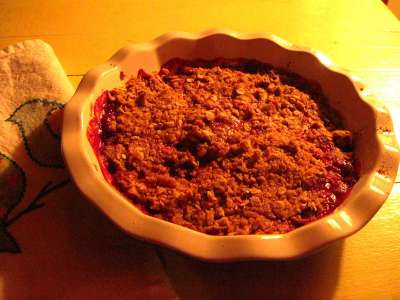
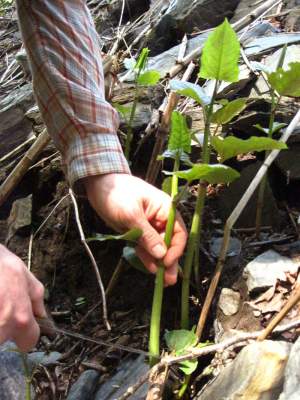
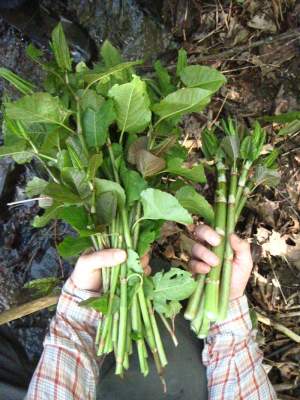
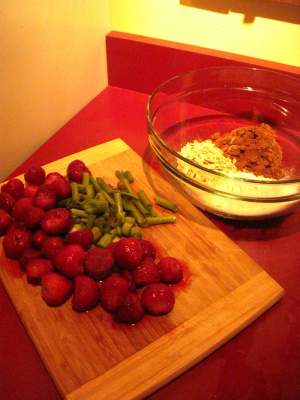
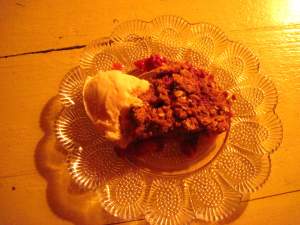
Discussion *